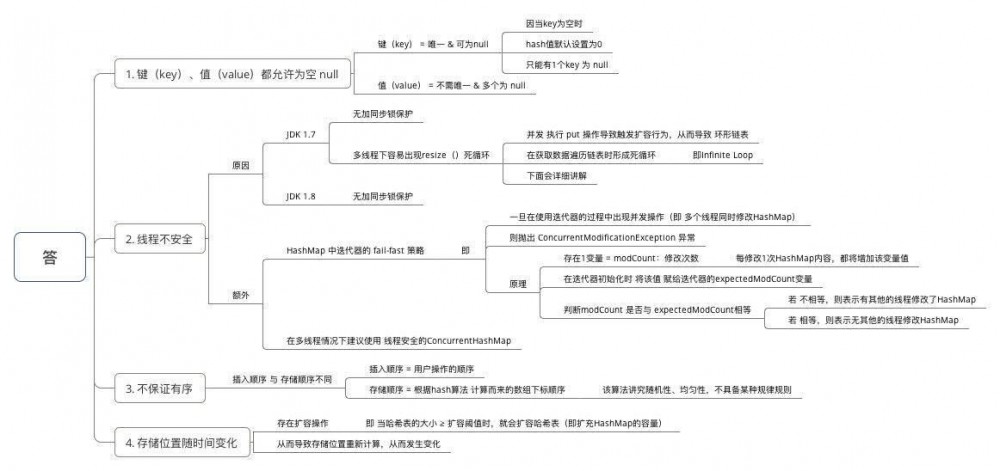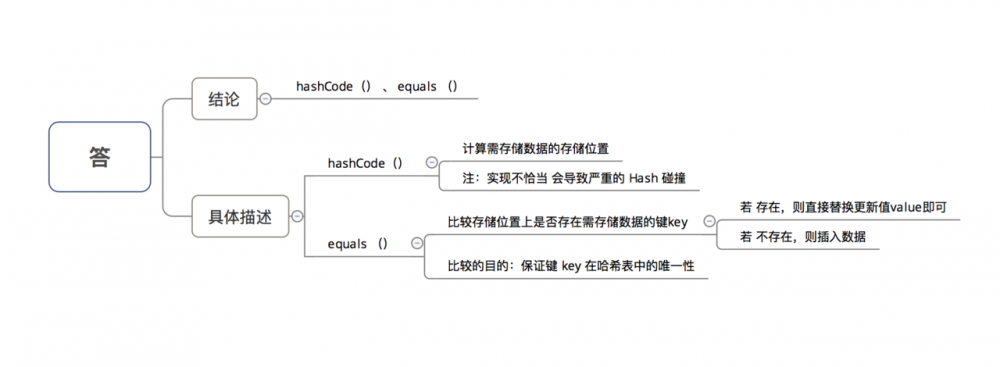哈?还在聊hashmap,老知识点了!
不就是一个hash加一个map嘛,多简单啊? 答:利用key的hashCode重新hash计算出当前对象的元素在数组中的下标,存储到数组里面就行了,底层就是数组嘛! 然后面试官说了句:好的,我知道了,回去听消息吧!

这种答复并不是面试官想要看到的,想要听到程序员有自己的理解和分析优化!
客官,来,1.7源码!
/**
*继承AbstractMap,并重写Map接口
**/
public class HashMap<K,V> extends AbstractMap<K,V>
implements Map<K,V>, Cloneable, Serializable
static final int DEFAULT_INITIAL_CAPACITY = 1 << 4; // 位运算,1左移4位=16
static final int MAXIMUM_CAPACITY = 1 << 30;//位运算,左移30位=1073741824
static final float DEFAULT_LOAD_FACTOR = 0.75f;//负载因子0.75
transient Entry<K,V>[] table;//entry数组 entry又是个单链表结构
transient int size;//hashmap长度
int threshold;//capacity * load factor 阈值比如16*0.75 = 12
void resize(int newCapacity);//扩容方法
static int indexFor(int h, int length) {
return h & (length-1);//计算index方法
}
void createEntry(int hash, K key, V value, int bucketIndex) {
Entry<K,V> e = table[bucketIndex];
table[bucketIndex] = new Entry<>(hash, key, value, e);//头插法解决hash冲突
size++;
}
复制代码
通过源码可以知道,HashMap的默认初始化长度为 1 << 4=16 ,最大容量为 1<<30=1073741824 . 可以看出1.7是采用 数组加单链表 的结构,Entry是一个继承 Map.Entry 的单链表结构。 size 就是hashmap的长度, threshold 就是插入扩容的阈值。 从 reSize 方法可以看出,1.7是 先进行扩容再插入 数据的。
别着急,1.7是怎么进行扩容再插入的嘛!
容量初始值为16,当插入数据数量大于阈值(capacity * load factor=12)并发生hash冲突时就进行扩容。每次扩容都是2的n次幂,这样好处就是利于位运算,并且length-1的二进制最后一位为1,减少了hash碰撞。且插入时是通过 int i = indexFor(e.hash, newCapacity); 重新计算的,即 hash & (length-1) ,并重新设置阈值(newCapacity * loadFactor)。
void resize(int newCapacity) {//扩容方法:resize(2 * table.length),当容量不足时(容量 > 阈值),则扩容(扩到2倍)
Entry[] oldTable = table;//复制旧的哈希表
int oldCapacity = oldTable.length;//旧的容量
if (oldCapacity == MAXIMUM_CAPACITY) //容量如果等于最大值,则不再扩容
threshold = Integer.MAX_VALUE;
return;
}
Entry[] newTable = new Entry[newCapacity];
boolean oldAltHashing = useAltHashing;
useAltHashing |= sun.misc.VM.isBooted() &&
(newCapacity >= Holder.ALTERNATIVE_HASHING_THRESHOLD);
boolean rehash = oldAltHashing ^ useAltHashing;
transfer(newTable, rehash);//转移数据到新哈希表里
table = newTable;//完成扩容
threshold = (int)Math.min(newCapacity * loadFactor, MAXIMUM_CAPACITY + 1);//重新设置阈值
}
void transfer(Entry[] newTable, boolean rehash) {//将旧哈希表的数据移到新的哈希表里
//过程:按旧链表的正序遍历链表、在新链表的头部依次插入
int newCapacity = newTable.length;
for (Entry<K,V> e : table) {//遍历哈希表
while(null != e) {
Entry<K,V> next = e.next;
if (rehash) {
e.hash = null == e.key ? 0 : hash(e.key);
}
int i = indexFor(e.hash, newCapacity);//重新计算index值
e.next = newTable[i];
newTable[i] = e;//头部插入
e = next;
}
}
}
复制代码
还有1.8吗,太难了。挺住,坚持坚持就看完了!

客官,还有1.8呢
public class HashMap<K,V> extends AbstractMap<K,V>
implements Map<K,V>, Cloneable, Serializable
static final int DEFAULT_INITIAL_CAPACITY = 1 << 4;
static final int MAXIMUM_CAPACITY = 1 << 30;
static final float DEFAULT_LOAD_FACTOR = 0.75f;
//Bins are converted to trees when adding an element to a bin with at least this many nodes.
static final int TREEIFY_THRESHOLD = 8;//当桶的节点数量大于该阈值时转换为红黑树
static final int UNTREEIFY_THRESHOLD = 6;//当桶的节点数小于该阈值时会转换成链表,前提是当前是红黑树结构
static final int MIN_TREEIFY_CAPACITY = 64;//桶的节点数大于该容量时也会转换成红黑树
static class Node<K,V> implements Map.Entry<K,V> ;//换成节点了
static final class TreeNode<K,V> extends LinkedHashMap.Entry<K,V>;//树节点
transient Node<K,V>[] table;//数组加单链表,后期会转红黑树
transient Set<Map.Entry<K,V>> entrySet;//数据的另一种存储方式,主要用于迭代功能
transient int size;//hashmap元素数量
transient int modCount;//该map的修改次数
复制代码
从源码可以看出,初始容量还是16,负载因子还是0.75,只是多了关于红黑树的知识点。1.8采用 数组加单链表加红黑树 的数据结构,扩容还是扩2的n次幂。
hash方法:
static final int hash(Object key) {
int h;
return (key == null) ? 0 : (h = key.hashCode()) ^ (h >>> 16);
}
复制代码
通过判断key值是否为空,如果空就为0,不为空就异或运算。
存值方法put
public V put(K key, V value) {//存值
return putVal(hash(key), key, value, false, true);
}
final V putVal(int hash, K key, V value, boolean onlyIfAbsent,boolean evict) {
Node<K,V>[] tab; Node<K,V> p; int n, i;
//获取长度并进行扩容,使用的是懒加载,table一开始是没有加载的,等put后才开始加载
if ((tab = table) == null || (n = tab.length) == 0)
n = (tab = resize()).length;
if ((p = tab[i = (n - 1) & hash]) == null)//(length-1)&hash计算出索引值,判断当前哈希桶是否为空
tab[i] = newNode(hash, key, value, null);//空就赋值给当前桶
else {//该哈希桶不为空,会发生hash冲突,以下为发生hash冲突几种情况
Node<K,V> e; K k;
//第一种情况,当前的hash值相同,且key值也相同,e = p表示首节点。
if (p.hash == hash &&
((k = p.key) == key || (key != null && key.equals(k))))
e = p;
//第二种情况,如果当前桶为树节点实例且不是首节点,即红黑树节点。是树节点则在红黑树中添加
else if (p instanceof TreeNode)
e = ((TreeNode<K,V>)p).putTreeVal(this, tab, hash, key, value);
else {//第三种,不为首节点,不为红黑树节点,则为链表节点
for (int binCount = 0; ; ++binCount) {
if ((e = p.next) == null) {//桶下个节点为空,则直接插入,尾插法
p.next = newNode(hash, key, value, null);
if (binCount >= TREEIFY_THRESHOLD - 1) // -1 for 1st
treeifyBin(tab, hash);//节点数大于等于7,则转换红黑树结构(从0开始到7)
break;
}
if (e.hash == hash &&
((k = e.key) == key || (key != null && key.equals(k))))
break;//插入节点与next节点重复,跳出循环
p = e;
}
}
if (e != null) { //在节点中存在重复的值,直接覆盖旧值
V oldValue = e.value;
if (!onlyIfAbsent || oldValue == null)
e.value = value;
afterNodeAccess(e);
return oldValue;
}
}
++modCount;//修改次数加一
if (++size > threshold)
resize();//容量增一,判断是否需要扩容
afterNodeInsertion(evict);//添加成功
return null;
}
复制代码
总的来说就是put的时候会进行判断当前桶是否为空,空就直接赋值。不为空且hash相同,则存在冲突,此时需要处理冲突的三种情况: ①当前桶不为空,且key值相同,则直接覆盖。 ②当前桶不为空,则桶节点不为首节点,且为红黑树节点,则在红黑树中添加。(节点数>=TREEIFY_THRESHOLD) ③当前桶为不为空,不为首节点,不为红黑树节点,则为链表节点。(节点数<TREEIFY_THRESHOLD)添加时如果大于等于7(从0到7),则需要转为红黑树节点。
插入值过后就需要判断容量问题,此时就需要 reSize() 方法,从上述的源码中if (++size > threshold)就知道JDK1.8是 先插入再进行判断扩容 的。当链表深度大于8时,会自动扩容为红黑树结构,时间复杂度从O(n)转到O(logn)
final Node<K,V>[] resize() {//扩容方法
Node<K,V>[] oldTab = table;//之前旧的哈希表
int oldCap = (oldTab == null) ? 0 : oldTab.length;
int oldThr = threshold;//old的表的阈值
int newCap, newThr = 0;
if (oldCap > 0) {
if (oldCap >= MAXIMUM_CAPACITY) {//容量大于最大值
threshold = Integer.MAX_VALUE;//此时阈值为整数最大值
return oldTab;//最大限度 不能扩容了
}//左移一位,新的哈希表扩容两倍,且要小于最大容量;且旧容量要比默认初始容量大
else if ((newCap = oldCap << 1) < MAXIMUM_CAPACITY &&
oldCap >= DEFAULT_INITIAL_CAPACITY)
newThr = oldThr << 1; // double threshold 阈值也要扩大两倍
}
else if (oldThr > 0) // initial capacity was placed in threshold
newCap = oldThr;//初始化的阈值
else { //容量为0,阈值就为容量*负载因子
newCap = DEFAULT_INITIAL_CAPACITY;//默认初始容量16
newThr = (int)(DEFAULT_LOAD_FACTOR * DEFAULT_INITIAL_CAPACITY);//阈值16*0.75=12
}
if (newThr == 0) {//如果初始化容量小于16时,没有阈值。因为构造函数可以自己设初始容量
float ft = (float)newCap * loadFactor;
newThr = (newCap < MAXIMUM_CAPACITY && ft < (float)MAXIMUM_CAPACITY ?
(int)ft : Integer.MAX_VALUE);
}
threshold = newThr;//赋值给阈值
@SuppressWarnings({"rawtypes","unchecked"})
Node<K,V>[] newTab = (Node<K,V>[])new Node[newCap];
table = newTab;//扩容后将旧的哈希表赋值到新的哈希表中
if (oldTab != null) {
for (int j = 0; j < oldCap; ++j) {
Node<K,V> e;
if ((e = oldTab[j]) != null) {//当前哈希桶节点为e
oldTab[j] = null;
if (e.next == null)//没有下个节点
newTab[e.hash & (newCap - 1)] = e;//重新计算index,放入新的哈希表中
else if (e instanceof TreeNode)//有next节点,且为树节点,将此树转移到新的cap中
((TreeNode<K,V>)e).split(this, newTab, j, oldCap);
else { // preserve order 链表情况,将链表插入到新的哈希表节点中
Node<K,V> loHead = null, loTail = null;
Node<K,V> hiHead = null, hiTail = null;
Node<K,V> next;
do {
next = e.next;//下一个节点
if ((e.hash & oldCap) == 0) {//当前桶节点为首节点
if (loTail == null)
loHead = e;
else
loTail.next = e;
loTail = e;
}
else {
if (hiTail == null)
hiHead = e;
else
hiTail.next = e;
hiTail = e;
}
} while ((e = next) != null);
if (loTail != null) {
loTail.next = null;
newTab[j] = loHead;
}
if (hiTail != null) {
hiTail.next = null;
newTab[j + oldCap] = hiHead;
}
}
}
}
}
return newTab;//返回新的哈希表
}
复制代码
总的来讲,插入数据后扩容过程分为以下几个 步骤 :
①当前容量是否超过最大容量,超过则不扩容,直接返回。且阈值(threshold)为整数的最大值 ②当前容量小于最大容量且大于初始容量。容量扩大两倍,阈值也扩大两倍
扩容后就将旧的表数据转移到新的表,利用 hash&length-1 计算index值,判断当前桶节点属于链表节点还是红黑树节点,再依次移入。
public V remove(Object key) {
Node<K,V> e;//判断删除的节点是否为空,不为空就返回该节点值
return (e = removeNode(hash(key), key, null, false, true)) == null ?
null : e.value;
}
final Node<K,V> removeNode(int hash, Object key, Object value,
boolean matchValue, boolean movable) {
Node<K,V>[] tab; Node<K,V> p; int n, index;
if ((tab = table) != null && (n = tab.length) > 0 &&
(p = tab[index = (n - 1) & hash]) != null) {
Node<K,V> node = null, e; K k; V v;
if (p.hash == hash &&
((k = p.key) == key || (key != null && key.equals(k))))
node = p;//获取当前的节点
else if ((e = p.next) != null) {//要删除的节点
if (p instanceof TreeNode)//下一个节点为树节点
node = ((TreeNode<K,V>)p).getTreeNode(hash, key);
else {//链表节点,遍历找到节点
do {
if (e.hash == hash &&
((k = e.key) == key ||
(key != null && key.equals(k)))) {
node = e;
break;
}
p = e;
} while ((e = e.next) != null);
}
}//遍历找到节点
if (node != null && (!matchValue || (v = node.value) == value ||
(value != null && value.equals(v)))) {
if (node instanceof TreeNode)//如果删除的是红黑树节点
((TreeNode<K,V>)node).removeTreeNode(this, tab, movable);
else if (node == p)//普通节点
tab[index] = node.next;
else//链表节点,修改next值
p.next = node.next;
++modCount;//修改次数加一
--size;//元素减一
afterNodeRemoval(node);
return node;
}
}
return null;//表示没有该节点,没找到
}
复制代码
区别加总结
相同点: 计算index都是 hash&length-1 不同点: ①JDK1.7时采用的是 数组加单链表 的数据结构,JDK1.8采用的是 数组加单链表加红黑树 的数据结构 ②1.7是 先扩容再插入 ,1.8是 先插入再扩容 ③解决冲突时,1.7是 头插法 的纵向延伸,但会容易逆序环形链表死循环问题;1.8是加入了红黑树,采用 尾插法 ,能够避免出现逆序死循环的问题。
HashMap有哪些不足,怎么解决和优化
hashmap具有键-值(key-value)都允许为空、线程不安全、不保证有序、存储位置随时间变化的特性,即

为什么 HashMap 中 String、Integer 这样的包装类适合作为 key 键

HashMap 中的 key若 Object类型, 则需实现哪些方法?

部分内容借鉴网址 :
www.jianshu.com/p/8324a3457…
确实写的好,佩服!
Hashmap确实还有很多可以深挖的知识点,这也是我第一次认真的写一篇文章,在我这么写了几千字的面子上就点个 小心心 呗,以后我会隔几天写一篇技术栈的文章并且同步到github上!有什么写的不好的地方和不足,欢迎大家指出!

隔壁写的实在是太好了,导致我有点力不从心,就这样吧!











![[HBLOG]公众号](https://www.liuhaihua.cn/img/qrcode_gzh.jpg)

